In order to understand the concept of wear leveling in SSDs, you’ll have to dive a little into the concept of NAND Flash storage. The data is stored inside the cells in the NAND Flash chips in your solid-state drive. These cells have a limited number of P/E (Program/Erase) cycles which when surpassed makes the NAND Flash either unreliable or sometimes, non-functional.
| NAND Type | P/E Cycles |
|---|---|
| SLC | ~100,000 – 300,000 cycles |
| MLC | ~3,000 – 10,000 cycles |
| TLC | ~1,000 – 3,000 cycles |
| QLC | ~100 – 1,000 cycles |
Now, the issue is that once any cell inside a drive crosses its P/E cycles, it will result in data retention issues, read/write problems, and sometimes drive failures. The real problem is that some of the cells or blocks are being used more frequently than others. So, these blocks are prone to more damage while some of the blocks are there with little to no damage at all.
So, to eliminate this uneven damage to the blocks, wear leveling comes into the game and distributes this damage.
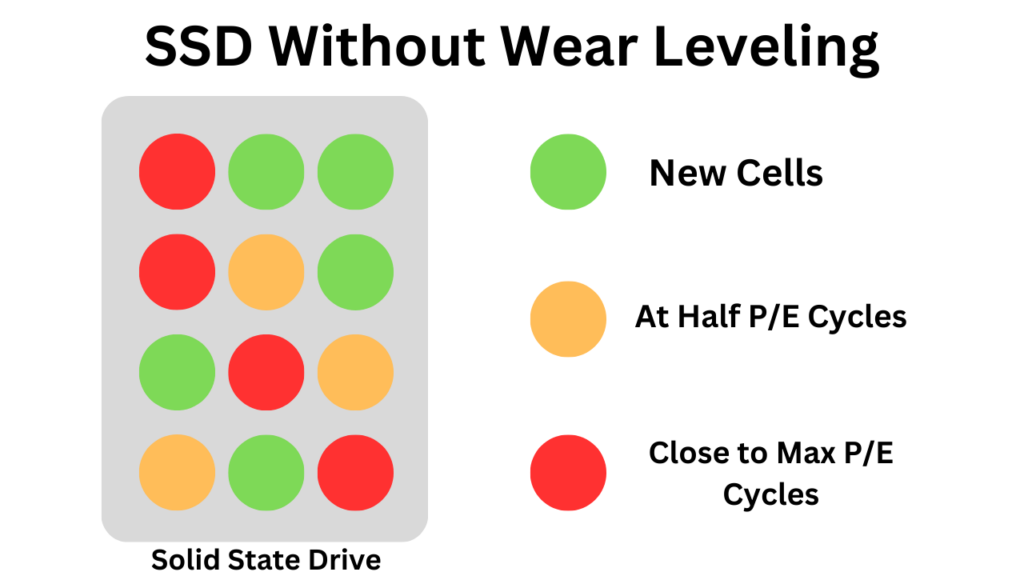
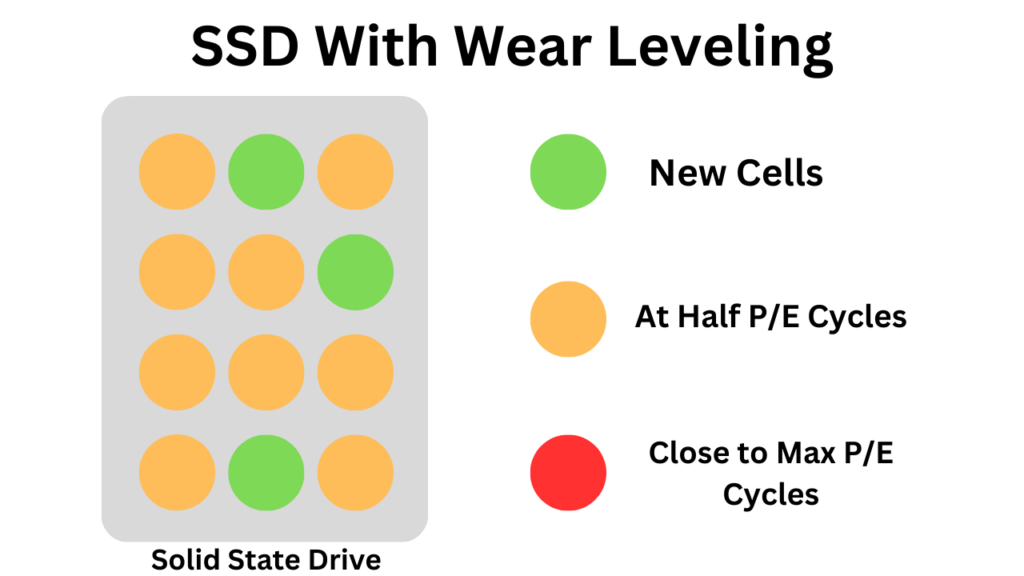
In simple terms, wear leveling is responsible for distributing the wear or the damage to the cells. It makes sure that all or most of the cells are facing the damage evenly. The controller makes sure that some blocks aren’t wearing out completely and become bad sectors while some are sitting idle.
What Is Wear Leveling In SSDs? (Technical Explanation)
*Data is stored inside the pages on NAND Flashes but blocks are the smallest entities that can be erased on NAND Flash.
You now know the concept of wear leveling. But, let’s understand it a little more technically on the level of the cell. We can take the example of an SLC cell which stores one bit of data (0 or 1) in the form of a charge. Let’s start.
The NAND Flash memory inside our SSDs utilizes Floating gate transistors which store the data in the form of an electric charge. Each time the data is written to or erased from the cell, a charge has to pass through a tunnel oxide layer to the floating gate. The floating gate is where the data is stored. This process is known as the P/E cycle.
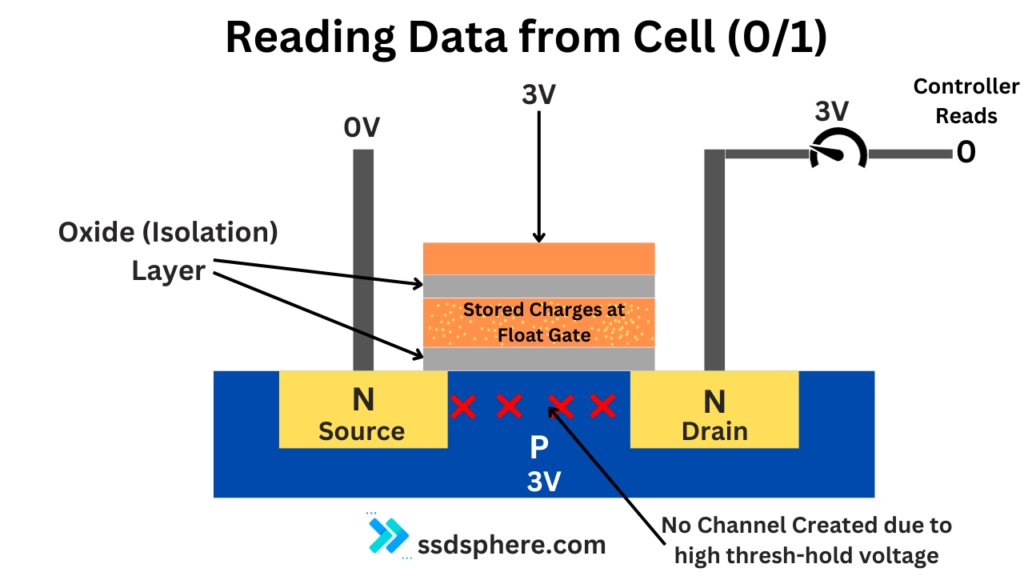
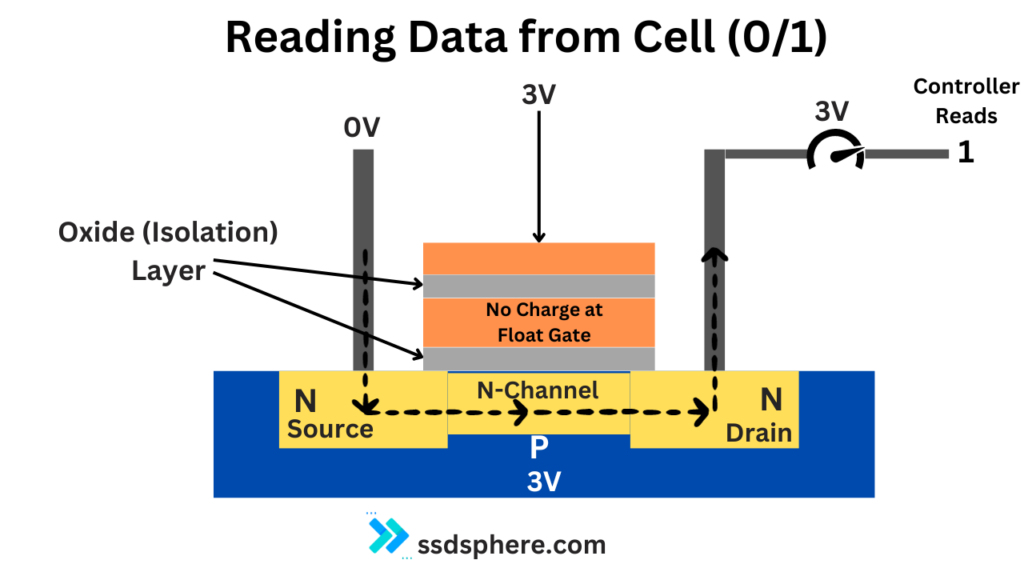
Now, when these charges keep passing through that oxide layer, it wears out. In modern NAND technologies, the oxide layer can be 20nm down to even sub-10nm thicknesses. So, this small layer is prone to wear.
Once this oxide layer is worn out, it will result in current leakage and voltage shift. When we see it practically, the drive starts to fail and the errors increase.
So, the wear leveling makes sure that any specific block isn’t getting utilized and others are kept idle. It keeps moving the data here and there to evenly divide the load in all the parts of the drive.
The main idea behind wear leveling is to distribute writes and erasures across the flash memory evenly. This ensures that no single block gets worn out faster than others, thus prolonging the life of the entire SSD. There are generally two types of wear leveling algorithms used: static and dynamic.
Different Types Of Wear Levelling In SSDs(Solid State Drives)
There are many Wear Leveling algorithms for SSDs but out of all the two are the main ones. The three main types of Wear leveling in SSDs are:
- Dynamic Wear leveling
- Static Wear leveling
To have a further understanding of these wear-leveling algorithms I will explain to you all these separately.
Dynamic Wear Leveling
Dynamic Wear leveling ensures that data is written on the blocks that have undergone the lowest erase count. This wear-leveling algorithm works only on blocks or areas that are not constantly modified in order to create a balance. However, it only considered the blocks that contain changeable data. As a result, the blocks that are rarely used don’t come under Dynamic wear leveling.
I hope this image will help you understand more clearly.
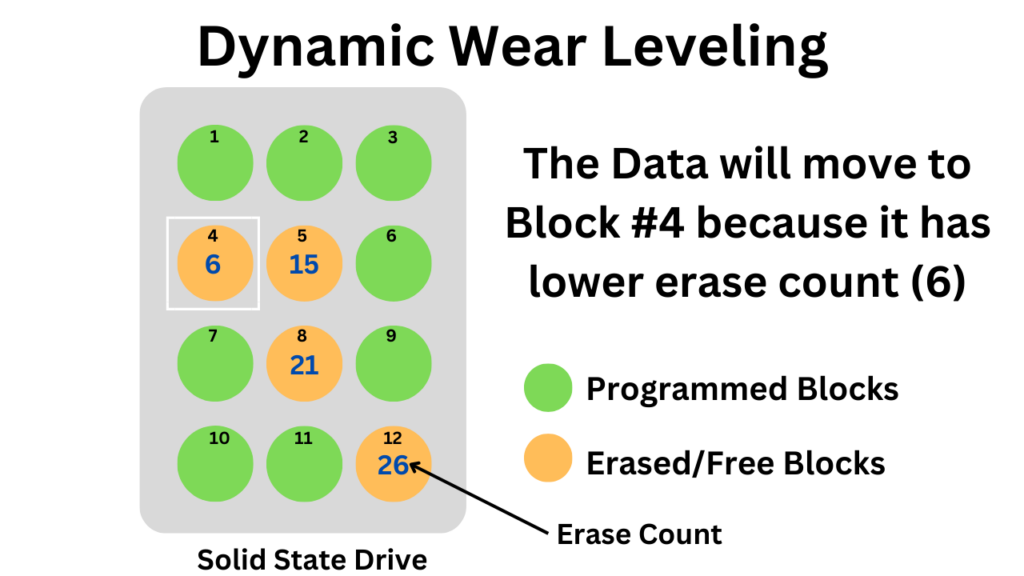
So, in dynamic wear leveling, the controller looks for the next free block to write the data with the lowest erase count. Once, a block with a 6 erase count reaches 16, it will write on the 5th block with a 15 erase count.
Dynamic wear leveling predominantly uses blocks that have been freed up and are available for new data storage. It has the advantage of less CPU overhead because no data is being moved here and there like static wear leveling.
But, the big drawback, as you can see in the image above, the blocks that are in the program state remain there sitting idle while some of the free blocks are being used over and over again.
It’s dynamic because it adjusts in real-time, based on how many times each block has been written.
Static Wear Leveling
In static wear leveling, the controller actually moves the data here and there to properly divide the wear. There is always a threshold erase count set by the controller. Once, any block reaches that limit, the cells that were sitting idle are erased and programmed. However, the ones with higher wear are used to store the information that those idle blocks were holding.

Usually, static data has a threshold of erase count. The memory blocks that start lagging due to erasing count are included in the wear-leveling blocks pool with their static data moved to blocks with higher erase counts. Static wear leveling is considered the best method to increase the lifespan of SSDs.
Static wear leveling is considered better for the drive health as compared to dynamic wear leveling. It utilizes much more CPU power but is considered a much more balanced approach.
A normal MLC SSD with an erase rate of 40 blocks per 10 minutes can increase the lifespan of an SSD by 15 years.
Difference Between Dynamic And Static Wear Leveling
| Dynamic Wear Levelling | Static Wear Leveling |
|---|---|
| Improves device life over no wear leveling at all | Maximizes device life |
| May Or May not optimize device life | Slows WRITE operations |
| Zero effect on device performance | High power consumption |
| It is quite easy to implement than static wear leveling | More complicated to implement as compared to dynamic wear leveling |
Importance Of Wear Leveling In SSDs
The continuous use of the same memory blocks every time exceeds the endurance of those blocks resulting in reducing the span of SSD life. To enhance the finite P/E(Program/Erase) cycles of NAND flash memory cells Wear leveling is required. In Nutshell, Wear Leveling is important to equalize the use of all memory cells to extend the life of an SSD. In the absence of wear leveling the storage cells of flash storage devices are not used efficiently. So, Wear Leveling not only increases the life of an SSD but also enables a justified usage of all storage blocks of the device. SSDs with well-implemented wear leveling are less likely to experience data corruption.
Let us see through an example:
Imagine an SSD that houses a total of 5,000 memory blocks. The set system parameters, allow up to 3% of blocks to become unreliable or bad over its usage period, equating to a maximum of 150 blocks that can turn bad without disrupting the functioning.
In a daily operation cycle, the SSD is tasked with updating five files every 15 minutes, each file occupying 60 blocks. Despite having a large pool of memory blocks to work with, the SSD, devoid of wear leveling technology, continuously reuses the same set of blocks for each update cycle.
Breaking Down the Usage
Every hour, the SSD updates a total of 20 files, utilizing a sum of 1200 blocks (20 files × 60 blocks/file). On a daily scale, 28,800 blocks are written and erased (1200 blocks/hour × 24 hours). This brings the annual usage to a significant figure of 10,512,000 blocks (28,800 blocks/day × 365 days/year).
The Outcome
The continuous and repeated use of the same blocks for every update amplifies the wear and tear exponentially. Within a span much shorter than a year, the SSD reaches a stage where the designated set of blocks utilized for the operations exceeds the allowable limit of 150 bad blocks, causing the SSD to fail prematurely.
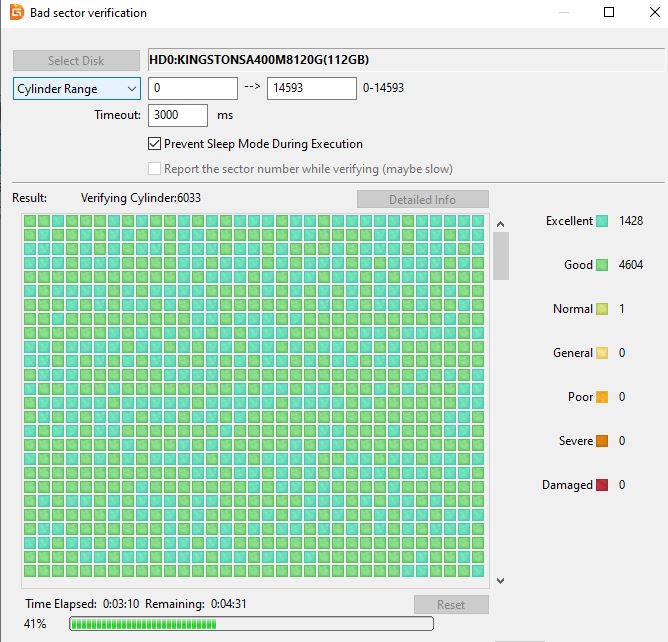
Some Common Scenarios
Scenario 1: The Student
Visualize a student working on a year-long research project, with the SSD storing vast amounts of data, from drafted versions to the final submission. Wear leveling ensures that every new save of the project doesn’t burden the same cells over and over, steering clear from potential cell failures and safeguarding the hard work put in throughout the year.
Scenario 2: The Gamer
Think of a gamer, whose SSD is home to numerous large gaming files. The constant updates and patches to games mean that the SSD is under continual write and erase cycles. In this environment, wear leveling ensures that the SSD does not face quick wear out, allowing for a smooth gaming experience with reduced lag and longer SSD life.
How to check Wear Level And Health Of Your SSD
Here are some applications that will help you in knowing the wear level of your SSD.
1. Hardware Monitor(For Windows)
Download hardware monitor application
Open the application and locate your SSD
3. DiskGenius (For Windows)
DiskGenius is a great software for checking and fixing bad sectors in SSDs. It is a free tool for various SSD security, recovery, and partition tools.
The Conclusion
Wear Leveling is one of the greatest technical operations working inside your drives. You should admire how this simple yet very effective technology operates and helps our drives manage their data and live longer.
Also, the Reading of data doesn’t cause any wear in SSDs. Wearing of SSDs is caused by writing and deleting data. In case you have any doubts regarding the same then do tell me in the comment section. I will be there for you.
Cheers!
Frequently Asked Questions
While wear leveling is fundamentally a controller-level hardware feature, it can also be supplemented through software solutions to monitor and enhance the efficiency of wear-leveling processes.
Though wear-leveling extends the lifespan of SSDs, it can introduce some computational overhead, which might slightly slow down the write operations. Additionally, static wear leveling can occasionally lead to write amplification, a phenomenon where more data than necessary is moved during the wear leveling process.
Manufacturers employ extensive testing and fine-tuning of the algorithms to ensure their efficiency. They might use simulations and real-world stress tests to optimize the wear leveling processes for different usage scenarios.
While it is technically possible for an SSD to function without wear leveling, it would lead to significantly reduced lifespan and potential data loss issues, making wear leveling almost universally adopted in modern SSDs.
Wear leveling ensures that no single cell is overused, thereby reducing the likelihood of cell failure and ensuring data integrity by maintaining the reliability of the storage medium over a more extended period.
While the core wear leveling processes are handled at the hardware level, users can support these efforts by optimizing their data storage practices, such as avoiding unnecessary write/erase cycles and using TRIM command support available in modern operating systems to help maintain SSD health.
Secure erasing or formatting an SSD generally does not reset the wear leveling count. The SSD continues to track the total number of write/erase cycles that each cell has undergone to effectively implement wear leveling strategies post the erase or format operation.